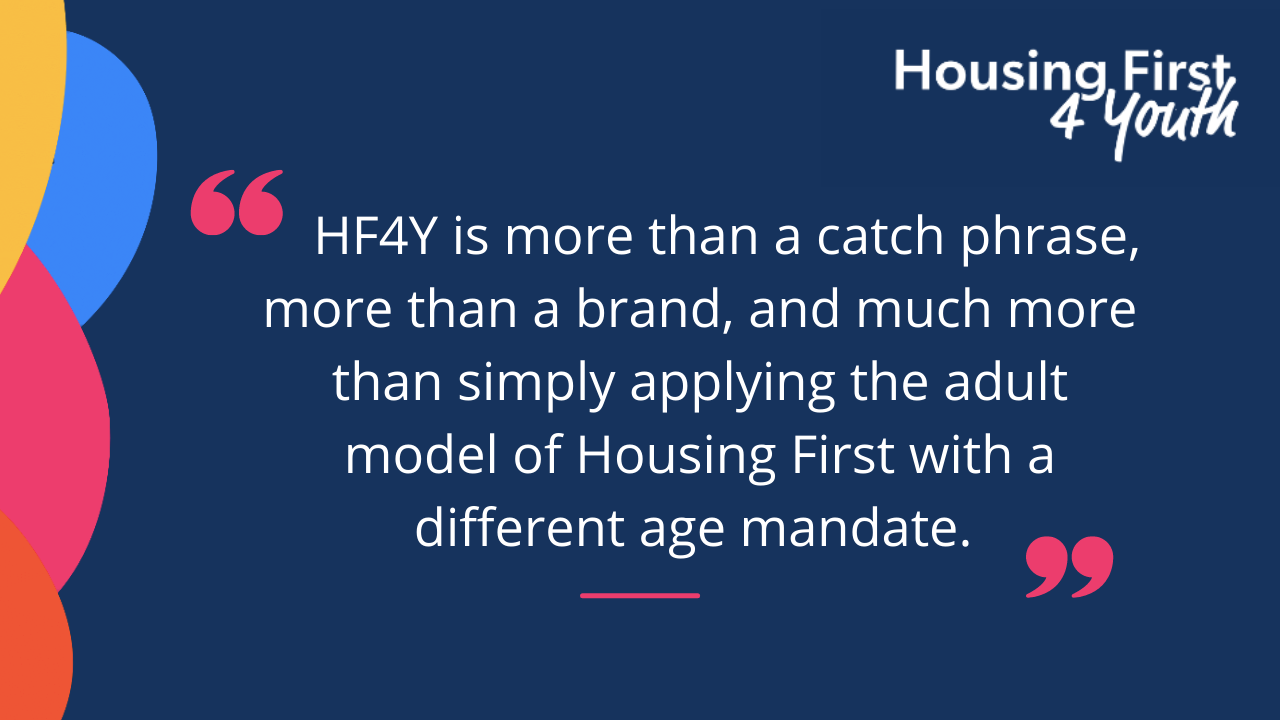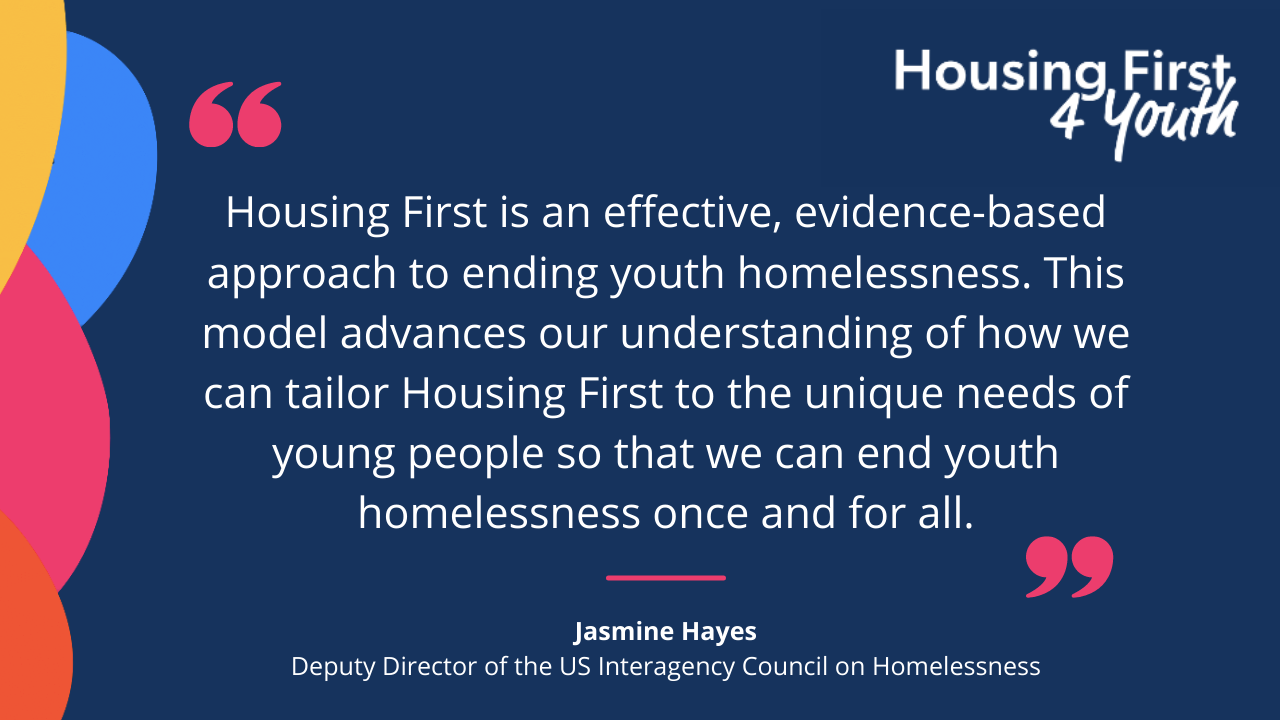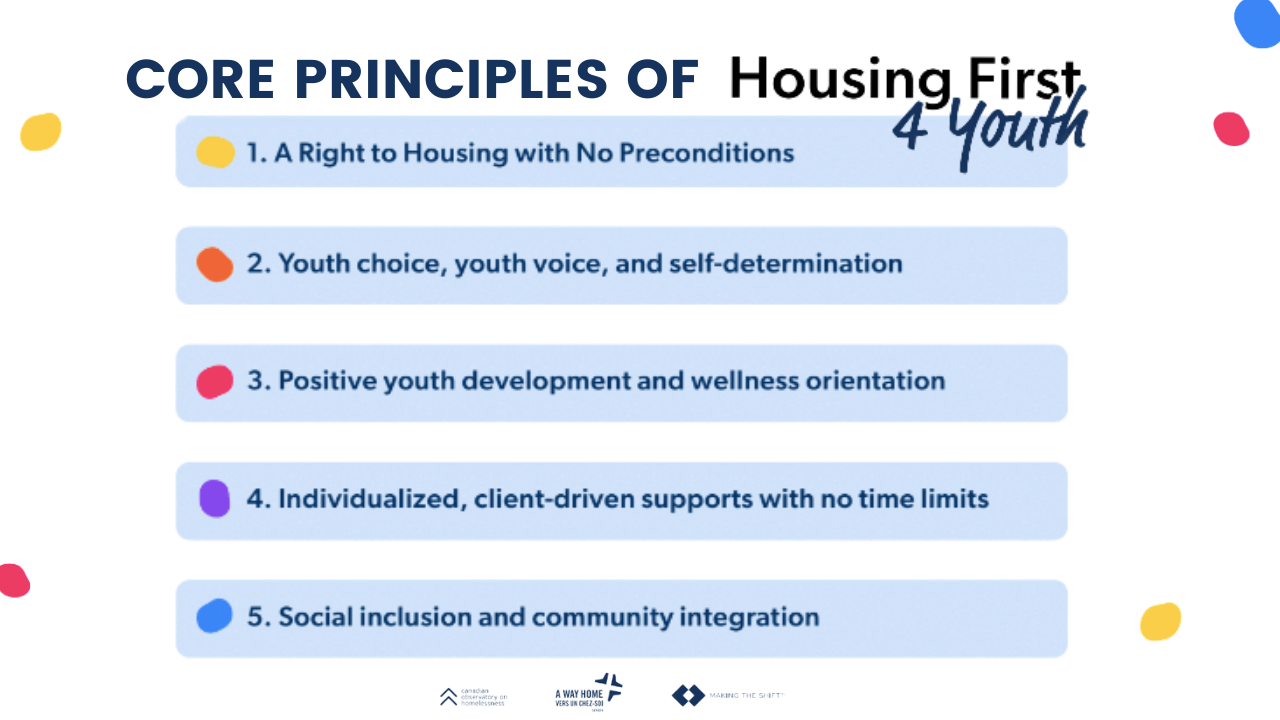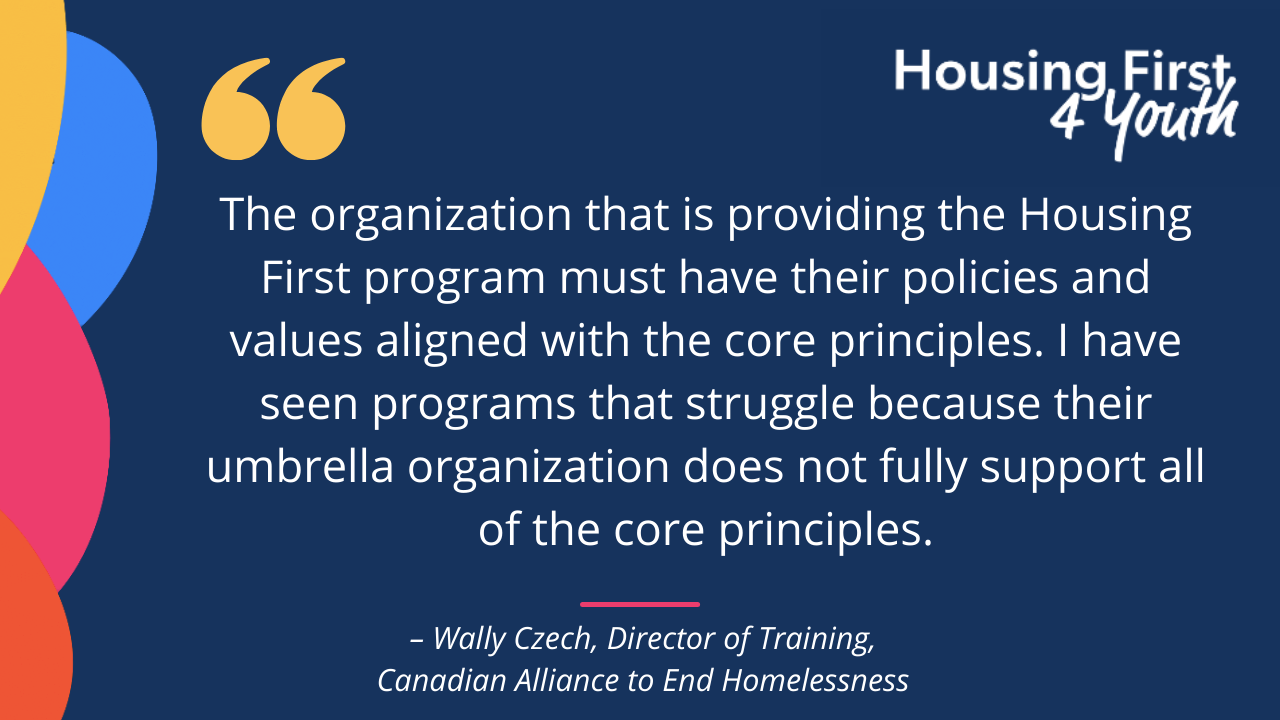As Housing First for Youth (HF4Y) gains popularity across Canada and internationally as an effective, evidence-based approach to prevent and end youth homelessness, there is one important thing to note: not all programs providing housing and support for youth qualify as HF4Y. And this distinction is critical.
For a program to be recognized as HF4Y, it must align with and stay true to the five core principles of the model. Put simply — if your program doesn't align with all five HF4Y core principles, it's not HF4Y.
Since the initial release of our framework towards HF4Y in 2014, there have been some misconceptions about what a HF4Y program entails. These misconceptions have led to programs being incorrectly implemented and program results inconsistent with the data that continues to point to HF4Y as a promising program model for preventing and ending youth homelessness. Inconsistent data means two things:
- It's harder to get organizations, communities, governments, and funders on board with implementing HF4Y
- Less youth experiencing homelessness will benefit from this youth-focused evidence-based program model that helps youth exit homelessness, stay housed and embark on a journey towards health and wellness

But not to worry! This blog will outline criteria you can use to make the distinction between what HF4Y is and isn't. Understanding this difference will not only be helpful for organizations and communities interested in implementing the program model but will also be helpful for governments, funders and decision-makers interested in investing in HF4Y.
Before we dive into what HF4Y is NOT, let’s touch briefly on what HF4Y IS.
What is HF4Y?
Housing First for Youth (HF4Y) is an adaptation of the well-established and successful Housing First approach used to address homelessness. Unlike Housing First though, HF4Y targets young people aged 13-24 and supports them to exit homelessness and transition to adulthood. At the foundation of the HF4Y model is the belief that housing is a human right, youth experience homelessness for different reasons than adults, and that their experiences while homeless are different as well.
Youth are cognitively and developmentally different than adults, and so solutions to their homelessness must be designed to appropriately meet both their cognitive and developmental needs. We need to protect and care for our youth in ways that respond to their realities — we cannot treat them as if they were adults. Research makes clear that youth who have experienced homelessness will do better and recover more effectively if they are first provided with housing, and then provided with supports to help make a healthy transition into adulthood.

The Core Principles of HF4Y
In order to understand HF4Y, you must know the five core principles well.
- A Right to Housing with No Preconditions
- Youth Choice, Youth Voice, and Self-determination
- Positive Youth Development and Wellness Orientation
- Individualized, Client-driven Supports with no Time Limits
- Social Inclusion and Community Integration
These principles serve as the backbone of the program model, and adhering to them is critical. These core principles should dictate how you plan and deliver all your services. They also function as a standard against which fidelity (degree of adherence to the HF4Y program model) can be assessed. In the case of HF4Y, fidelity is crucial to achieving the best results for youth.

Types of Programs That Do NOT Qualify as HF4Y
Now that we’ve touched on what HF4Y IS, let’s get to why you’re reading this blog — let’s explore what HF4Y is NOT.
While a broad range of housing-led programs may support youth under the age of 25 or specifically target youth, not all of these interventions are consistent with the HF4Y model.
For example, some programs may provide temporary or interim housing, such as:
- Transitional housing
- Supportive housing and supported lodgings
- Agency-specific housing that requires young people to move out once they have completed the program or have reached a specific age
These programs often require youth to comply with a series of conditions, which may include:
- Time limits on how long young people can access services
- Discharge from the program regardless of whether a young person has achieved housing and financial stability
- Lack of separation of housing from other supports
- Withdrawal of housing once a young person exits the program
- Mandatory participation in education or employment
- Adopt abstinence in the context of substance use disorders
None of these conditions are consistent with the HF4Y core principles.
Another example of housing programs that are not HF4Y is Housing First programs designed for adults that extend their services to young people under the age of 25. These programs are not specifically designed to meet the unique needs of developing adolescents and young people — which means they are not consistent with HF4Y core principles.
Unfortunately, if your program meets any of the above criteria, it does not qualify as HF4Y.
Clarifying What HF4Y is NOT
Here are some additional criteria that can help to determine whether or not a program qualifies as HF4Y.
A program does not qualify as HF4Y if it:
- Does not believe that housing is a human right
- Requires youth to achieve sobriety, or be enrolled in employment programs before providing housing support
- Is a housing program with a time limit
- Is a housing program that supports youth & adults within the same case management structure
- Places time limits on how long youth can access additional support programming
- Uses a one-size-fits-all approach to working with youth because there isn’t enough staff or resources to tailor supports to the unique needs of each youth
- Staff caseloads exceed 10
- Does not actively engage family and natural supports
- Does not work to support youth with healthy integration within their community and the development of positive social relationships
- Does not include youth in the decision-making process about what neighbourhood they will live in or what support programs and services they access
- Does not see mental and physical wellness as essential to helping youth stay youth and avoid falling back into homelessness
When trying to determine whether or not a program can or should be called HF4Y, ask yourself the following:
Does the program:
- Provide housing with no preconditions?
- Respect a youth's right to choice and self-determination?
- Orient itself around youth development & wellness?
- Offer individualized supports with no time limits?
- Provide appropriate financial supports & rent supplements?
- Have caseloads between 7-10 to support the unique needs and provide intensive case management to each individual youth?
- Support youth with community integration & social inclusion?
- Seek out and engage family and natural supports to ensure youth have the opportunity to rebuild and create relationships that are not professional?
If the answer to any of the above questions is NO, then the program does not qualify as HF4Y and should not be labelled as such.

Key Takeaways
The key takeaway here is that any program that claims to be HF4Y must align and demonstrate fidelity with HF4Y's core principles. In other words, HF4Y requires fidelity (accurate adherence to the model) to produce the best chance of preventing and ending youth homelessness. It’s worth repeating: if your program doesn’t align with all five HF4Y core principles, it’s not HF4Y. For this reason, it's important to understand what types of programs constitute HF4Y and which do not. Providing housing and/or supports for young people does not in and of itself make a program HF4Y.
For a HF4Y program to be successful in preventing and ending homelessness, it must:
- Provide housing with no preconditions
- Respect a youth's right to choice and self-determination
- Be oriented around youth development & wellness
- Offer individualized supports with no time limits
- Incorporate social and community integration
To help your organization and staff stay true to the HF4Y, download this printable PDF of the five core HF4Y principles. It includes detailed descriptions of each principle and can be used as a job aid for existing staff or training for new staff.
Interested in Implementing a HF4Y Program in Your Community?
Download the complete HF4Y program model guide, operations manual, and accompanying tools & templates here.
You can also take our free, self-paced HF4Y online training on the Homelessness Learning Hub.
For virtual or in person support, A Way Home Canada offers hands-on practical training and program implementation for your HF4Y program. For more information, contact info@awayhome.ca
Heidi Walter from A Way Home Canada and Steve Gaetz from the Canadian Observatory on Homelessness were contributors to this blog.

